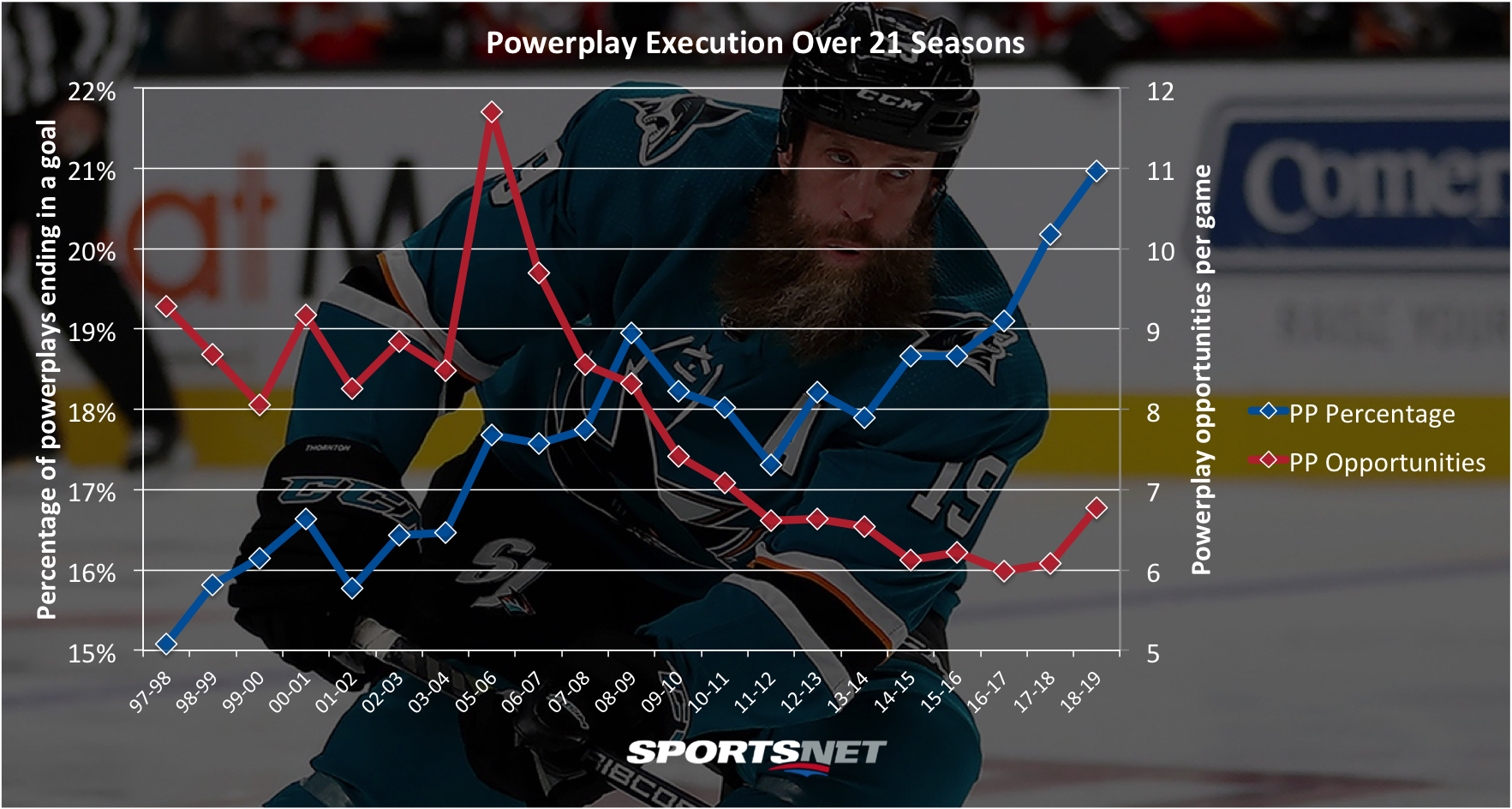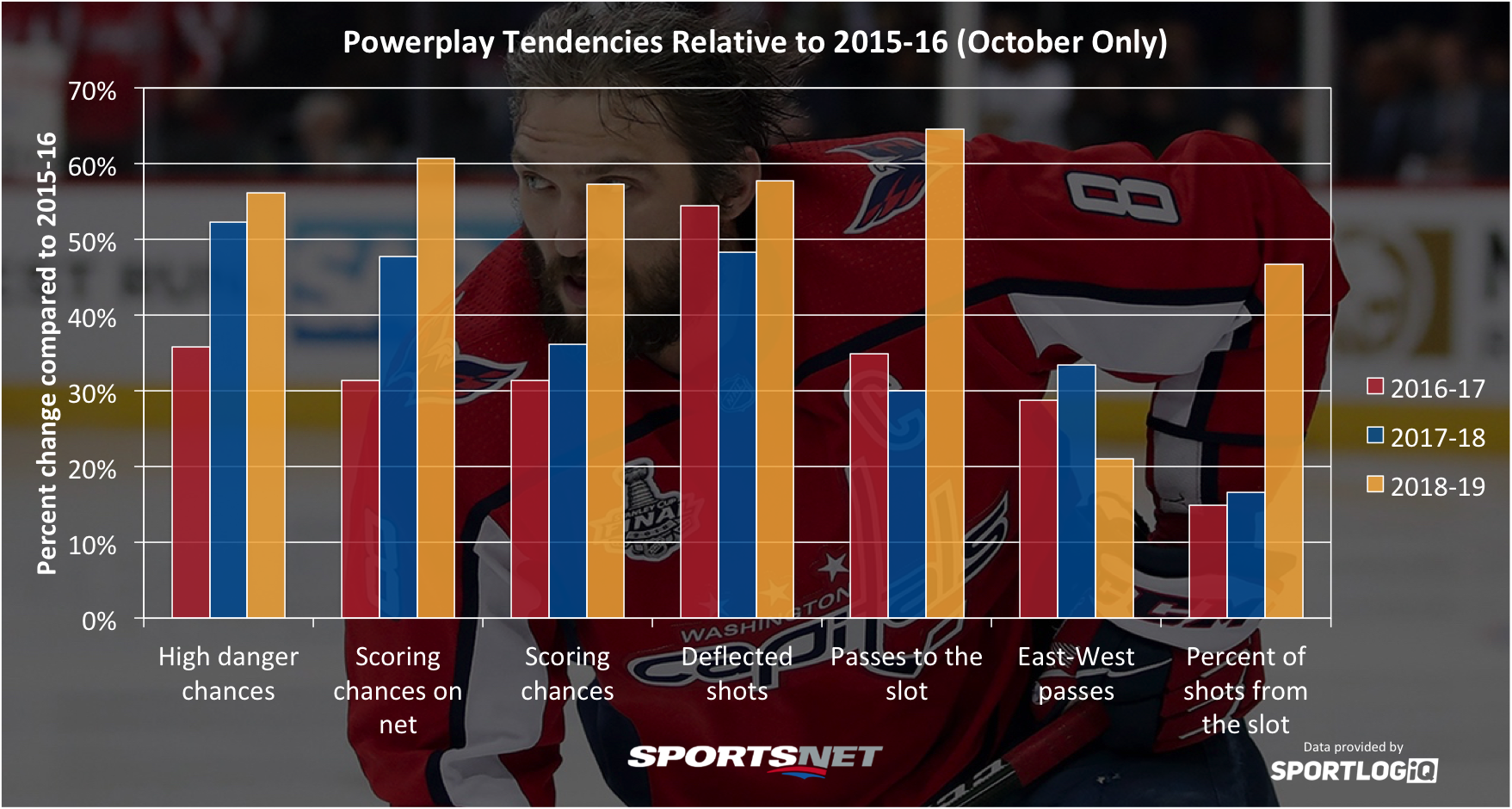A few weeks into the 2018-19 NHL season, a familiar trend is happening: goals per game are up and save percentage is down for the third straight season. Equipment changes, specifically smaller chest pads, are likely partially to thank for that, and October is always a messy month as teams figure out tweaks to their systems and rookies fight for jobs, but this is an emerging trend in the NHL.
The 2015-16 season averaged just 5.42 goals per game between the two teams according to Hockey Reference. This was the lowest mark since 2001-02, the height of the dead puck era, despite the introduction of 3-on-3 overtime presumably increasing goal scoring. The following season saw a modest climb to 5.54 goals per game, while last season there was a huge jump to 5.94 goals per game, the highest mark since the crackdown on obstruction in the 2005-06 season following the lockout. Teams averaged 6.24 goals per game between them that season.
This year has seen yet another jump up to 6.24 goals per game. And while some of that is due to the messiness of October, by the end of the season we will likely see a modest increase over 2017-18 as well.
[snippet ID=3322139]
Conveniently, 2015-16 is also the first season SPORTLOGiQ recorded league-wide microstat data, which can give us some insight into why goal scoring has increased.
Surprisingly, even strength save percentage has actually risen ever so slightly over this period, despite the fact that teams have increased their scoring chance production year over year. Power plays, however, have become significantly more lethal.
This is apparent even looking at Hockey Reference, as you can plot out the changes in power play efficiency over the previous 20 seasons before 2018-19.

Conveniently, 1997-98 represents the lowest average power play efficiency since 1963-64 when the statistic was first recorded, so we can see a not entirely linear, but still very obvious 20-plus year trend of power plays becoming more dangerous.
Interestingly, we see that over the past 10 seasons there have been fewer power play opportunities than there were in the Dead Puck Era, and while efficiency declined at the beginning of this drop, it has been steadily on the rise since the shortened 2013 season – and has exploded over the past three seasons.
My hypothesis here is the half season off from the absolute bedlam of an NHL coaching routine helped some smart people in the game develop new strategies to better operate on the power play. Coaches aren’t dumb and they can see power plays are becoming less frequent, so it’s now more important than ever to take advantage when you can.
What did they change though? Again, we get the convenient stagnant point in 2015-16, so we can compare each of the following seasons to that one and analyze which kind of plays increased in frequency and by how much on a per minute basis.
To be fair, we’ll compare October hockey this season to October hockey from each of the seasons in question.

It’s not surprising to see increases across the board here, but the extent of those increases is astonishing. Since 2015-16 the average NHL power play has increased its high danger scoring chances by more than 56 per cent and scoring chances on net by more than 60 per cent. The average PP unit moves the puck into the slot with pre-shot movement almost 65 per cent more often, and the percentage of total shot attempts taken within the slot is up nearly 47 per cent.
East-West passes have increased compared to 2015-16, but they’re down this season, and there’s a reason for that. Most East-West passes on the power play are between defencemen, and frankly, the point shot on the power play is going the way of the dodo.
More than ever, teams are realizing that unless you have Shea Weber back there, whose mind-bendingly excellent shot scored at a 20 per cent clip from the point over the past four seasons, shots from that far out aren’t that dangerous. Point shots have an average conversion rate of about four per cent, and though that increases on the power play due to better pre-shot movement, it’s not by as much as you would think.
Teams who rely on point shots from their defencemen, no matter how talented (except for maybe Weber), are quickly left behind in power play efficiency. Just ask the Nashville Predators, who have the most talented group of offensive defencemen in the NHL, and only have an average power play since 2016-17 despite being a stellar even strength scoring team.
Teams have realized that using defencemen as support players, often only putting one out on the power play, makes far more sense than organizing your man advantage around a slap shot from 50 feet out.
The question then becomes, are power plays just good early in the year when team defence isn’t as tight? Let’s compare what we have this season to the past three full seasons.

Over full seasons, the improvements do look a bit smaller, but one reason for that is power plays actually got better as the 2015-16 season went on. But while scoring chances, shot distance and passing plays all improved as the 2016-17 and 2017-18 seasons progressed, the power play conversion rate actually went down slightly.
My guess as to why this happens is goalies perfect their timing, and as they face more shots through a season they improve. This is a bit of a wild guess though, because I’m not sure what else would explain power play efficiency not rising despite better chances being created. It wouldn’t make sense to say it was defensive structure if those chances exist in the first place.
The overarching point here, though, is that power plays are scoring more despite getting less opportunity, which is the main reason scoring is up in the NHL. Goalies are still getting better every year — that isn’t going to change any time soon — but smarter coaching has put some power back in the hands of goal scorers, and that’s a good thing for the league.
If the NHL called the rule book a little stricter and didn’t give us an era with the fewest power play opportunities in league history, we may see an even greater shift in power towards offence.
[relatedlinks]







